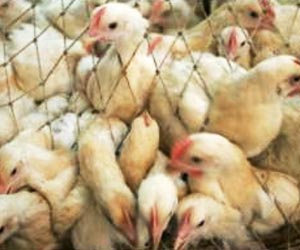Health workers in eastern India battled Friday to contain an "alarming" outbreak of bird flu amid reports the virus had spread to new areas and local people were resisting a mass poultry cull.
State officials in densely-populated West Bengal said chickens were still on sale despite a ban, while New Delhi called in troops to prevent birds being smuggled out.The state's chief minister Buddhadeb Bhattacharjee described the spread of the virus as "alarming".
The minister told the Press Trust of India (PTI) his government had upped the cull target to 400,000 poultry, adding that the Rampurhat sub-division of Birbhum district was the worst affected.
He added that poultry in a five to 10 kilometre (three to six mile) radius of the affected areas would be culled and that it would take seven days.
"We have decided to increase the strength of the culling teams," Bhattacharjee said after culling got off to a slow start Wednesday.
Some 30 million rupees (770,000 dollars) had been set aside to compensate poultry owners.
Advertisement
"The situation is very, very serious in 102 villages in three districts of Birbhum, Murshidabad and South Dinajpur," West Bengal animal resources development minister Anisur Rahaman said.
Advertisement
But he said there had been no reports of human cases since the outbreak of the disease, although isolation wards have been readied in local hospitals.
In New Delhi, a home ministry official said the paramilitary Border Security Force had been called in to stop chickens being smuggled into Bangladesh, where the virus has also broken out.
But West Bengal health services director Sanchita Baksi said villagers were throwing chicken carcasses into rivers and ponds, increasing the risk of the virus spreading.
"And in some areas, villagers are feasting on dead chickens and are reluctant to disclose if there are any chickens or ducks in their backyards.
"Thousands of people are in danger," she warned, adding that local hostility was hampering efforts of the cull, which was launched after the agriculture ministry confirmed the presence of the deadly H5N1 strain.
The federal government has sent advisories to states neighbouring West Bengal in a bid to contain the disease.
More than 62,000 chickens and ducks have died over the past week in the three districts affected, West Bengal animal resources development director Dilip Das said.
Baksi said there were reports other birds had also been infected.
"We are worried over the reports that crows and hawks are dropping dead in some bird-flu affected areas," she said.
"We are trying to tell the people not to touch any birds lying in the those places."
Humans typically acquire the disease by coming into direct contact with infected poultry, but experts fear the deadly virus may mutate into a form easily transmissible between people.
Wild migratory birds have been blamed for the global spread of the disease, which has killed more than 200 people worldwide since 2003.
The outbreak is the third in India, home to 1.1 billion people, since 2006.
Source-AFP
LIN/S





